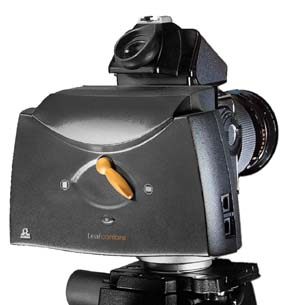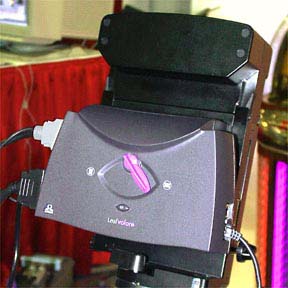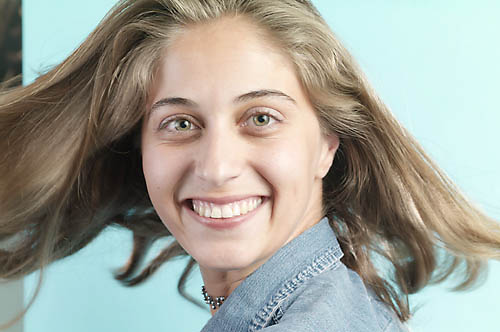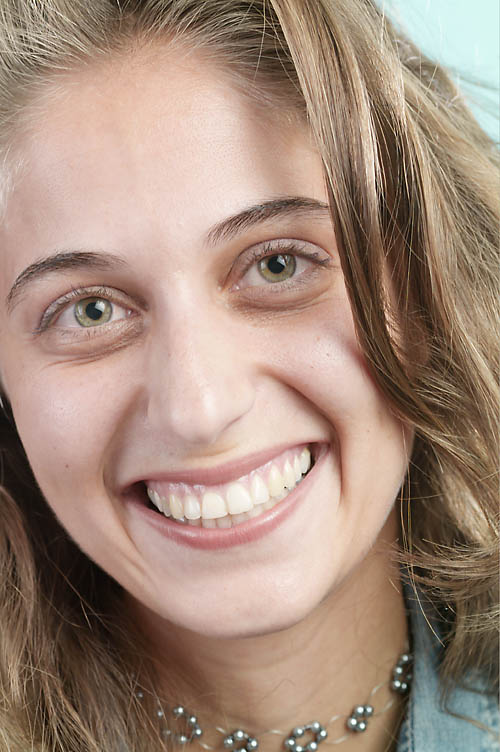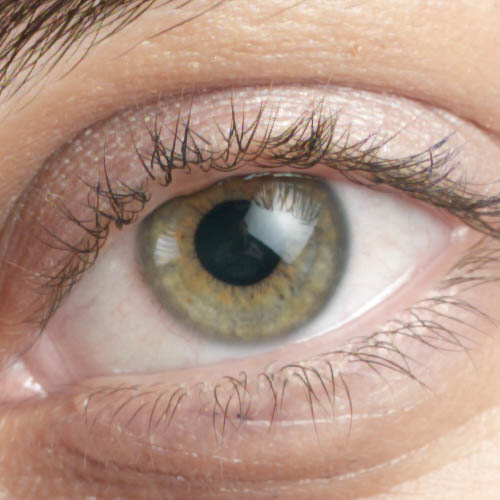The Leaf Volare and Cantare digital camera backs
by John Henshall
One manufacturer has set the benchmark for high-end professional digital cameras since introducing the first professional studio camera at Photokina in 1992. That company is Leaf. These days, Leaf is one of a number of digital camera manufacturers which use the 24 x 36 mm CCD made by Philips. So are they all virtually the same?Leaf Systems Inc began as an American company, which in 1992 was acquired by the Scitex Corporation, an Israeli-based multi-national founded in 1968 by Efi Erazi. Before Scitex, Efi Erazi worked at MIT on the first ever digital video camera -- the one which Neil Armstrong used to send back the first live images from the surface of the moon. Originally known as Scientific Technology Ltd, the first products, such as a helicopter image stabiliser, were for military use. In 1970, the company became Scientific Textiles, Sci-Tex, whose work included the digitisation of the Jacquard loom and the ink jet printing of carpets. This technology lead to Scitex producing 'Response 300', the world's first digital pre-press system, in 1979, and the first digital page-makeup program, the 'Vista' system -- at $350,000 including mini-computer. In 1990 Scitex acquired Iris Graphics Inc of Bedford Massachusetts, realising that their high quality colour ink jet printers could be used for digital proofing. In the one thousand feet per minute, black only, ink jet field, Scitex acquired the Dayton Ohio facility from Kodak in 1993. These printers have many uses, such as the printing of bank statements and the addressing of newspapers and, in the future, they may also be used for high-speed variable data colour printing.
The original Leaf Digital Camera Back (see Chip Shop April 1993) produced 2048 x 2048 pixel images of such outstanding quality that this camera alone confirmed the future of high quality digital acquisition. The original DCB required three sequential exposures, through red, green and blue filters, though a single-shot Catchlight version followed. The current Leaf DCB-II Live has a built-in cooling system which maintains the CCD at 0°C. Leaf also produced a small, low cost scanning camera, the Lumina, which had a Nikon lens mount.
Leaf showed the Volare, the first camera back to use the new 2048 x 3072 pixel 24 x 36 mm FTF3020 CCD from Philips Semiconductors in Eindhoven, at Seybold Seminars in San Francisco in August 1998. Volare is a three-shot camera featuring the Leaf Active Cooling System, which controls the temperature of the CCD. This is an important feature for photographers who want the highest picture quality, for it increases dynamic range, helps maintain clean, noise-free images in hot studios, and enables the use of exposure times of up to thirty two seconds, without noticeable build-up of noise.
I visited Scitex Corporation Ltd in Israel in May 1999, to discuss and use their forthcoming single-shot camera back, the Leaf Cantare.
A visit to a camera manufacturer speaks volumes about that company, even before a word is said. Are the cameras made by the company itself, or are they designed and manufactured outside by a third party, reducing the company to little more than a sales and marketing, packing and shipping organisation? What is the after-sales back up like? Is there on-going refinement of hardware and software?
There was no doubt on any of these points at Scitex. Research, design, software, manufacture, assembly, testing, packing and marketing is all done in-house by a close-knit team. I saw it all. The Input Systems Division, responsible for digital photography and scanning, is run as one of a series of autonomous internal divisions. The relaxed working atmosphere says it all: dedicated perfection with good humour and not a suit or tie in sight, even in the President's office. Mind you, in Israel it's 40°C outside. Scitex is the kind of place where you immediately feel at ease and inspired. Even the choice of coffee and hot chocolate flavours is studied with care. Scitex exudes confidence and reassurance about product continuation and backup, important if you are going to invest in their products.
Cantare is the single-shot variant of Volare using the striped version of the Philips 2x3K chip -- also used in the Phase One LightPhase and MegaVision S3 backs -- but with a big difference. The Cantare is the only single-shot back to use active cooling of the chip. Other manufacturers use techniques to avoid the chip being heated (such as only powering the back during exposure and keeping most circuitry out of the back) but if the studio is at 35°C then the camera back will also be at 35°C or higher. And the noise will be four times as much as it would have been at 19°C. This noise shows in smooth shadows and obscures fine detail. Asked how important active cooling is, Scitex's digital photography guru Yossi Ben-shoshan says, "It's like baseball. You don't have to wear special shoes to play baseball but, if you're a professional player, they certainly help."
Yoav Chelouche is the President
and Chief Executive Officer of Scitex Corporation
Ltd, headquartered in Herzliya, a suburb of Tel
Aviv, Israel. He has presided over a major
turnaround in Scitex's fortunes and created a
series of autonomous internal divisions -- virtual
sub-companies which share the umbrella and
facilities of the parent company as
required. One of the major facilities,
shared by the autonomous Scitex divisions, is the
state-of-the-art computerised engineering
workshop. This on-site facility
manufactures parts for Scitex products at prices
far below those which would be paid if the work was
contracted out. Leaf uses about 10% of the capacity
of the engineering facility and could not itself
afford to have such a sophisticated workshop. Some
of the parts produced are large and of high
precision, such as this drum... ...for the futuristically
designed Scitex Dolev image setter. Another section manufactures
printed circuit boards. These reels contain
thousands of microchips ... ... which are automatically
assembled on the boards by this machine. The man behind every Leaf camera
to date is Yossi Ben-shoshan. In 1992 he moved from
Scitex America to their new acquisition, Leaf
Systems Inc. There he was responsible for the Leaf
DCB (Digital Camera Back), first shown at Photokina
in 1992. In 1996 he took the Leaf subsidiary home
to Israel, to take advantage of in-house
manufacturing facilities and the synergy between
Leaf and the Input Systems Division in digital
imaging acquisition and color processing. Yossi
Ben-shoshan is widely regarded as one of the
world's leading experts in professional camera
design. He is also a perfectionist. Every Volare and Cantare board
is tested before being installed in a new
camera. The board is connected by ribbon
cables to a skeletal camera back containing a CCD,
mounted on a Hasselblad back. Testing ensures that the PCB
meets quality and functionality requirements before
being installed in a production camera
back. The Volare/Cantare body is a
single machined casting. The main board is mounted in the
back of the housing. The 'VH Twist' assembly, which
rotates the CCD between portrait (V) and landscape
(H) modes, fits into the front of the casting.
One of Leaf's unique features is
its active Peltier-effect cooling of the Philips 24
x 36 mm CCD. The heat exchanger fits into the
rotator unit. It is spring loaded, to keep it in
contact with the back of the CCD. A fan removes the
heat dissipated by the heat exchanger from the
back. The CCD is mounted on a circular
printed circuit board. This board contains the head
amplifier and is connected to the main board by a
flexible ribbon cable. The CCD and board is fitted onto
the VH Twist unit... ...which allows it to rotate
through 90 degrees. At this stage, the CCD is
protected by a cover. CCDs are sensitive to infra-red,
so an IR filter is mounted in front of the chip. It
must be cleaned very carefully to avoid any dust
close to the focal plane. A neoprene gasket seals the
space between the back of the filter and the front
of the CCD, to prevent the ingress of
dust. The IR filter assembly is then
fixed in position. The final part of the mechanical
assembly is the precision alignment of the CCD in
the focal plane using a microscope. Alignment must
be accurate in both landscape and portrait
modes. The microscope is first focussed
onto the backplate which interfaces with the back
of the camera. The CCD is then aligned to
this. Assembly and alignment
completed, the camera back is tested for
performance and to reveal any picture
blemishes. Finally, the backs are 'soak'
tested to ensure reliability.

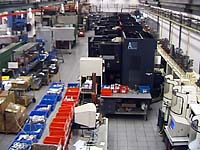
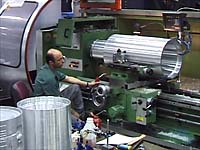
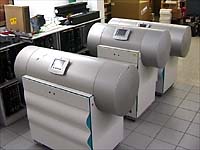
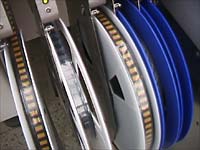
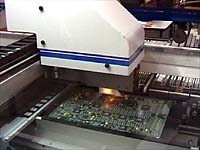
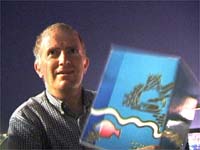
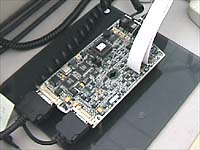
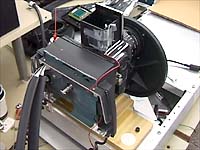
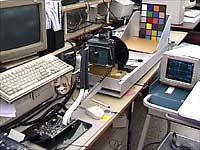
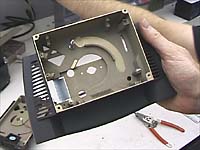
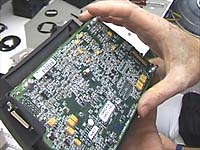
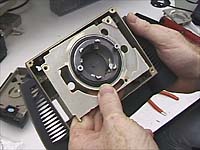
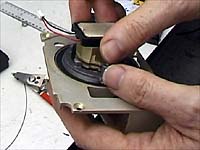
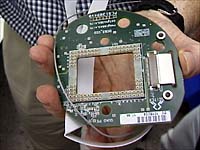
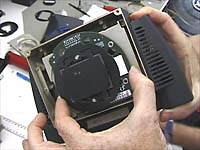
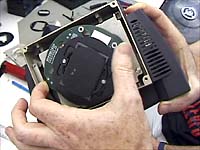
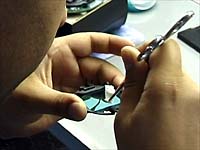
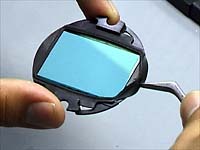
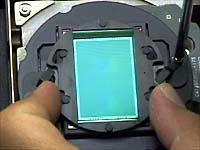
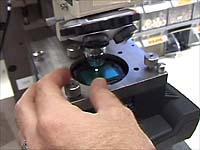
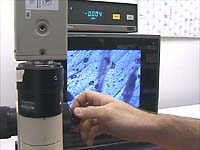
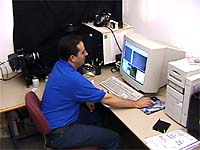
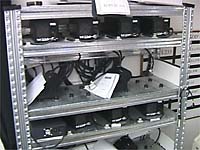
THE RESULT IS THE NEW LEAF CANTARE
The new Leaf Cantare single-shot camera back mounted on Hasselblad.
(Camera spotters tip: Instantly recognisable by the orange VH Twist control)
OR THE LEAF VOLARE
The original Leaf Volare three-shot camera back mounted on Sinarcam.
(Camera spotters tip: Instantly recognisable by the purple VH Twist control)
SHOOTING WITH VOLARE AND CANTARE
How three-shot and single-shot compare
Over the past few months I have been very impressed by single-shot camera backs using the Philips 2x3K chip, even to the point of wondering whether a three-shot is worth the hassle or limitations. I therefore grasped the opportunity to compare Volare and Cantare side-by-side on the same subject with enthusiasm.
The two cameras share many of the same facilities, such as Leaf VH Twist rotating the entire chip between landscape and portrait shooting modes, CCD cooling, software user interface, Live Focus, contrast meter for critical focussing at a distance (shown full size at left) and toning after shooting. A Leaf Digital Layout facility allows an art director's layout -- or a previous shot -- to be superimposed as an aid to accurate composition. The Cantare has Rapid Shoot capability, allowing successive shots to be captured every 1.3 seconds. Shots are displayed immediately on a digital contact sheet on the computer screen. The area selected for critical Live Focus actually moves as the lens is focussed, tracking as changes in image magnification during focussing move the selected area across the frame slightly.
A collection of beer bottles provided an effective, if somewhat unimaginative, subject for the comparison. Foil wrapping produced some specular highlights and fine detail close to highlight level. The superior depth of colour and tone of the three-shot Volare was immediately noticeable but only in direct comparison with the single-shot Cantare. Closer examination showed the superior resolution of three-shot. This is hardly surprising as three exposures produce three times as much image data as a single shot. The black 'Quality' lettering on a red background on the label of the right hand bottle was a particular challenge for the Cantare. Fine black lettering on a red background is always a problem for single-shot cameras -- try including a Heinz baked beans tin in your test shots.
The new Cantare, on a Hasselblad, was crying out to be hand held and that's how I used it, for portraits. At 20 x 13 x 9.5 cm (8 x 5 x 4 inches) and 1.3 kg (2.86 lb) it is a little on the bulky side and a good grip would be useful. The VH Twist mechanism makes changing between landscape and portrait modes as easy as flicking the switch. No right-angled viewfinder is needed for the Hasselblad. Other manufacturers' interpolation software seems to soften the 'a' and 'b' colour channels in Lab mode, either leaving the 'L' luminance channel or even sharpening it somewhat. The Leaf interpolation software I used was still in Beta form. It does not soften the 'a' and 'b' channels but still manages virtually to eliminate colour aliasing.
Leaf Active Cooling makes a big difference to both backs. Switching off the cooling and allowing the back to warm up to (air conditioned) room temperature produced a noticeable increase in noise which would be seen on big enlargements.

The digital contact sheet.
So which should you buy, Volare or Cantare? Both are state-of-the-art products, produced by a team of perfectionists, with no compromises. Without a doubt, the three-shot Volare produces the cleaner, sharper images, with great colour and tonal depth and capable of the greatest enlargement. Purists and lovers of 4 x 5 will love its images. But it cannot capture live subjects. The new single-shot Cantare can capture every type of subject and, if your requirements are not for such big enlargements, the Cantare would be a good all-purpose choice. But if you want the very highest quality -- better than any single shot -- you need the Volare. You may even want to buy one of each.
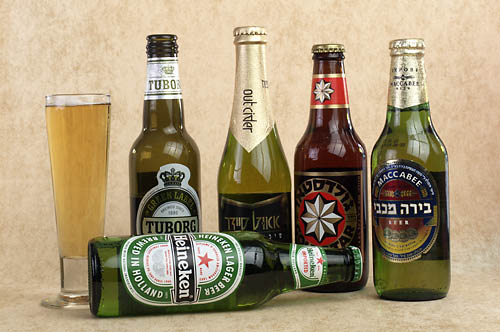
Captured with
the Leaf Volare (three-shot)

Captured with
the Leaf Cantare (single-shot)
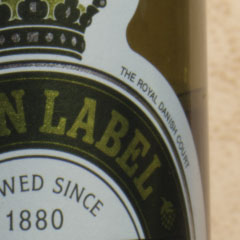
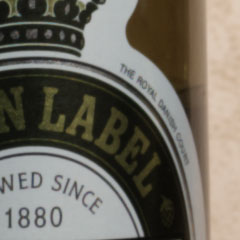
Sections of the above shots (left) Volare (right) Cantare displayed here at 100% (one image pixel displayed as one screen pixel.) These sections have not been enhanced in any way. Note the superior resolution of the three-shot back and the lack of visible colour aliasing in the Cantare example. At this size of enlargement, a print of the whole image would measure over 108 x 72 cm (42 x 28 inches).
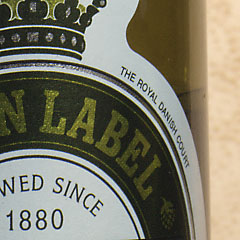
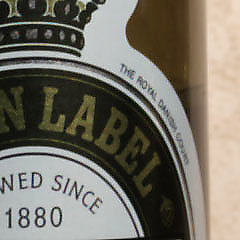
The same sections (left) Volare (right) Cantare with Unsharp Masking applied. Note how much better the cleaner Volare image takes the sharpening. It also takes interpolation better.
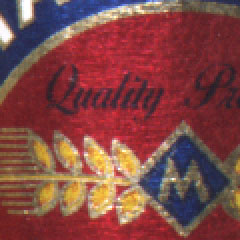
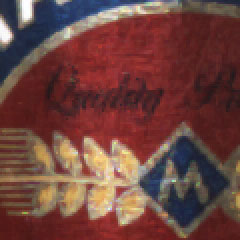
Further sections of the above shots (left) Volare (right) Cantare, displayed here at 200% (one image pixel displayed as two screen pixels.) These sections have not been enhanced in any way. Fine black lettering on a red background is a particular challenge for single shot digital cameras. At this size of enlargement, a print of the whole image would measure over 217 x 144 cm (85 x 56 inches).
The big advantage of the Cantare is its ability to capture action.
This section of a Cantare image is displayed at 100% (one image pixel displayed as one screen pixel) and has not been enhanced in any way. At this size of enlargement, a print of the whole image would measure over 72 x 108 cm (28 x 42 inches).
 left
to right: Dennis Kaliser, Yossi Ben-shoshan, Ilan
Carmi and Shiri Brickman.
left
to right: Dennis Kaliser, Yossi Ben-shoshan, Ilan
Carmi and Shiri Brickman. |
Special thanks to Yossi Ben-shoshan (Program Manager, Digital Photography Products), Adina Shorr (General Manager, Input Division), Amit Shvartz (Marketing Director), Ilan Carmi (Product Marketing Manager), Stanley Barkan, Dennis Kaliser, Shiri Brickman, Laura Laloum, my long-suffering and beautiful subject Ronit Konfidan, and Yoav Chelouche. For further information about Leaf Digital Photography see www.scitex.com/products/input/leaf/index.htm For general information about Scitex Corporation see www.scitex.com The Leaf Volare is priced at £15,995 (US$25,000), the Cantare is £14,495 (US$23,000). In the UK
contact Silicon Imaging Ltd at +44 (0)207 538
1010 |
|
The editorial images for this article were photographed in available light using a Sony DCR-TRV900 digital video camera. The still frames were captured from the DV tape using a FireWire card and PhotoDV from Digital Origin (formerly Radius Inc.) The portrait of Yoav Chelouche was photographed using a Nikon CoolPix 950 digital camera using an available mixture of daylight and flourescent light. Test shots using the Leaf Volare and Cantare digital camera backs were made by John Henshall in Leaf's in-house test studio in Herzliya, Israel, on 26 May 1999. |
|
DIGITAL IMAGING SECRETS -- special interest seminar Want to know more about Leaf's digital products and philosophy? Yossi Ben-shoshan is widely regarded as one of the world's leading experts in professional camera design. He is one of the many designers and users who will share their experience with you, first-hand, at the whole-day Digital Imaging Secrets special interest seminar at Seybold San Francisco on Monday 30 August 1999. Also on this day will be the first public showing of a fully working Nikon D1 digital camera. We have a page with further information about this special day, which is being organized by EPIcentre's John Henshall. Don't miss this rare opportunity to evaluate some of the important developments that will have a profound effect on your imaging productivity and profitability. We look forward to seeing you there. Full information on the Seybold San Francisco seminars and expo website. |
This is an extended version of the article which first appeared as "John Henshall's Chip Shop" in "The Photographer" magazine, June 1999.
IMPORTANT NOTICE
This document is Copyright © 1999 John Henshall. All rights reserved.
This material may only be downloaded for personal non-commercial use. Please safeguard the future of online publishing by respecting this copyright and the rights of all other authors of material on the Internet.
